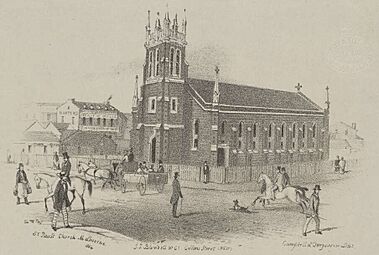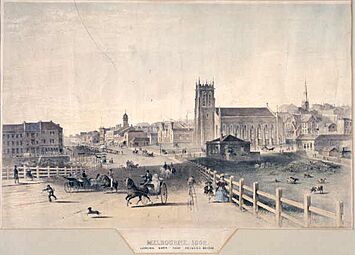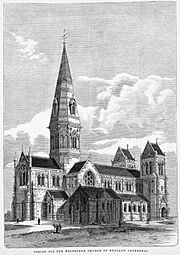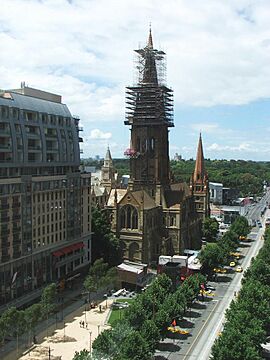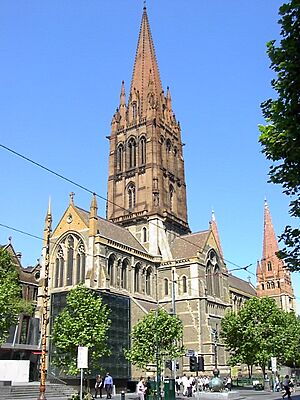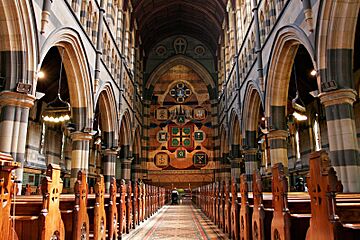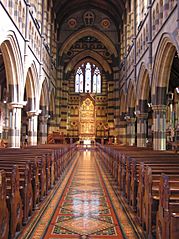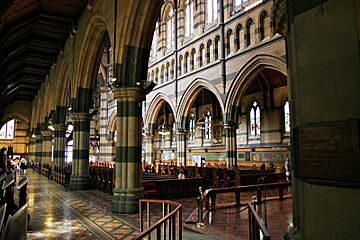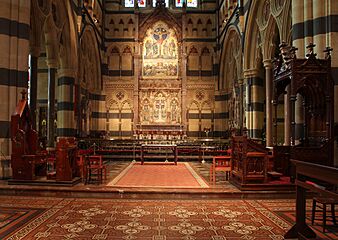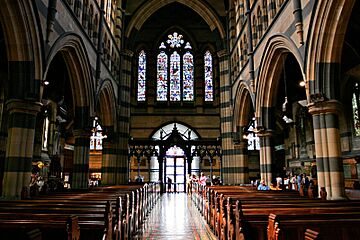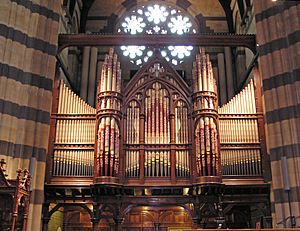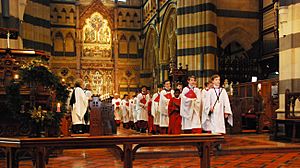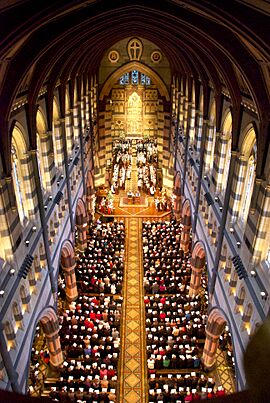St Paul's Cathedral, Melbourne facts for kids
Quick facts for kids St Paul's Cathedral, Melbourne |
|
|---|---|
| Cathedral Church of Paul the Apostle | |
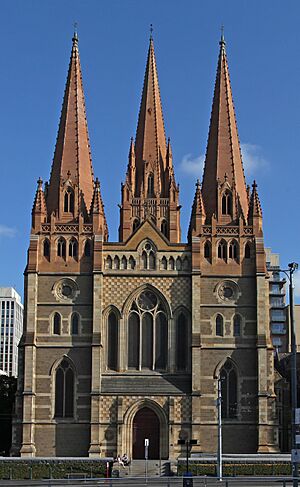
St Paul's Cathedral
|
|
| 37°49′01″S 144°58′03″E / 37.816853°S 144.967384°E | |
| Location | Melbourne CBD |
| Country | Australia |
| Denomination | Anglican Church of Australia |
| History | |
| Former name(s) | St Paul's Parish Church (1852–1885) |
| Status | Active |
| Consecrated | 22 January 1891 |
| Architecture | |
| Architect(s) | William Butterfield |
| Style | Gothic Revival |
| Years built | 1880–1891, 1926 |
| Administration | |
| Diocese | Melbourne |
| Province | Victoria |
St Paul's Cathedral is a famous Anglican church in Melbourne, Australia. It is the main church for the Diocese of Melbourne. It is also where the Archbishop of Melbourne has his official seat.
The cathedral was designed by William Butterfield, an English architect known for his Gothic Revival style. Most of the building was finished in 1891. The tall spires were added later, between 1926 and 1932, with a different design. St Paul's Cathedral is one of Melbourne's most important buildings.
Contents
Where is St Paul's Cathedral?
St Paul's Cathedral is in a very important spot in the middle of Melbourne. It sits on the corner of Swanston and Flinders streets. Right across the street is Flinders Street Station, which was a busy transport hub in the 1800s and still is today.
Just south of the cathedral, across Flinders Street, is Federation Square. This is a modern public area in Melbourne. If you keep going south on Swanston Street, you cross Princes Bridge over the Yarra River. This means the cathedral stands out when you approach the city from the south.
The place where the cathedral stands is special. It's where the first Christian church service in Melbourne happened in 1835. Before the cathedral, there was a market for corn and a church called St Paul's Parish Church on this site.
History of the Cathedral
How it Started
St Paul's Cathedral is built on the exact spot where the first public Christian service in Melbourne took place in 1835. Back then, this area was a government reserve. It was quite far from the town's main area and was used as a corn market.
By 1848, the site was next to the first Princes Bridge over the Yarra River. This important spot was given to the Anglican Church. A church made of bluestone (a type of dark grey rock) called St Paul the Apostle was opened in 1852.
An artist from that time, Samuel Thomas Gill, drew St Paul's Church in 1854. A print of his drawing, called 'St. Paul's Church Melbourne 1854', is now kept by the National Library of Australia.
About 30 years later, Melbourne had grown a lot. Swanston Street became a major road. The church leaders decided to build a grand new cathedral on the site. It would replace the older St James Old Cathedral from 1839.
They asked William Butterfield, a famous English architect, to design the new cathedral. He was known for his unique Gothic Revival style. To fit the city's layout, the cathedral faces north-south, not east as churches usually do.
The first stone was laid in 1880 by the Governor of Victoria, John, Earl of Hopetoun. On January 22, 1891, the cathedral was officially opened. This was before the spires were built.
Building the cathedral had some disagreements between Butterfield and the church in Melbourne. Butterfield even quit in 1884. Another architect, Joseph Reed, then finished the building. He mostly followed Butterfield's plans. Reed also designed the nearby chapter house in a similar style in 1889.
The large pipe organ was ordered from T. C. Lewis, a well-known organ builder from England.
The 1900s and 2000s
For almost 40 years, the cathedral did not have its tall spires. It looked more solid and flat. But it was still a popular subject for postcards and photos. In the early 1920s, a competition was held to design new spires.
John Barr from Sydney won the competition in 1925. His design was in a traditional Gothic Revival style. The main spire was much taller than Butterfield's original idea. Building started in July 1926. The stone used for the spires was different from the original building.
The central tower was named the Moorhouse Spire. It reached its full height of 95 meters (312 feet) in 1932. A special service was held on April 30, 1933, to celebrate its completion. The tower of St Paul's became the tallest building in central Melbourne for a while.
While the towers were being built, the Chapter House was also made bigger. It gained one more section and an extra floor. This work was done in 1926 by architects Gawler & Drummond.
In the 1960s, a lot of work was done on the outside of the cathedral. In 1989, the organ was fixed up with help from a big fundraising effort. More major repairs happened in 2009. This included fixing the spires and adding a colorful glass lantern to the Moorhouse Tower. New glass doors were also installed at the main entrance.
As more tall buildings were built in central Melbourne, St Paul's was no longer the tallest. However, it still stands out in its immediate area. For about 30 years, it was overshadowed by the 16-story Gas & Fuel buildings. These were built nearby in 1967 but were taken down in 1997 to make way for Federation Square.

By the 1990s, the constant traffic in Melbourne caused worries about the cathedral's structure. Especially the spires were a concern. A public appeal, led by the Dean of Melbourne, David Richardson, raised A$18 million. This money was used to restore the spires and improve the inside of the building.
The restoration project took seven years and finished in 2009. It was praised by architects and heritage groups. As part of the work, stone faces of Dean David Richardson and Dame Elisabeth Murdoch were added to the spires. New colored glass art was also created for the west doors and the "Eighth Day" lantern in the Moorhouse Tower.
Besides Sunday and weekday services, the cathedral has a daily choral Evensong. This is a special evening service with singing. It is the only Anglican cathedral in Australia to do this every day.
Cathedral Design
St Paul's Cathedral is shaped like a traditional Latin cross. It has a long main area called the nave, with aisles on the sides. There are also shorter sections called transepts. A tower stands where the nave and transepts meet. The choir sings below this tower, and the altar is further back. Two towers frame the main entrance.
The cathedral is built from two types of stone. There's sandstone from the Barrabool Hills and Waurn Ponds limestone. This gives the cathedral a warm, yellowish color. This is different from many other large 19th-century buildings in Melbourne, which use lighter sandstone. It also looks very different from the dark bluestone Gothic style of St Patrick's Roman Catholic cathedral. The spires are a darker color because they were built 40 years later using Sydney sandstone.
The inside of the cathedral is very colorful. It has strong color contrasts, which was typical of Butterfield's designs. All the stone inside is Waurn Ponds limestone. It has stripes of very dark bluestone for contrast. The lower walls, floor, main altar, and reredos (a screen behind the altar) are great examples of colorful High Victorian Gothic style. The reredos is made of marble, alabaster, and shiny Venetian glass mosaics.
One of the carved figures on the pulpit (where sermons are given) is said to look like the daughter of a former Mayor of Melbourne, who passed away as a baby. The floor is covered with encaustic tiles from England. These tiles have both patterns and designs within them. The lower walls also have patterned glazed tiles.
On the back wall of the entrance area, there is a special Persian tile. It is a copy of an 8-pointed star found in two churches in Iran. There are two baptismal fonts (basins for baptisms). The round font was put in when the cathedral was first built. In 1912, a larger font for immersion (where a person can be fully dipped) was built to remember Bishop Field Flowers Goe.
Music at St Paul's
Music is a very important part of services at St Paul's. You can hear many types of Anglican church music during worship. The person in charge of music at the cathedral is the director of music. A special group, started in 1993, helps fund the cathedral's music programs.
Director of Music
Until 2013, the director of music at St Paul's Cathedral was also the organist.
- Ernest Wood, 1888–1914
- A. E. Floyd, 1914–1947
- C. C. Campbell Ross, 1947–1951
- Lance Hardy, 1951–1973
- June Nixon AM, 1973–2013
- Philip Nicholls, 2013–present
June Nixon, a former director of music, received a special award in 1999. This was for her long work in church music and for playing the organ. She was the first woman to receive this honor.
The Organ
The cathedral's large pipe organ was built by T. C. Lewis and Co in England. It cost a lot of money to build, ship, and install. It was first played at the cathedral's opening service in 1891. Since then, it has been updated and maintained many times. A big restoration finished in 1990, costing A$726,000.
The restored organ has four keyboards and pedals. It has 53 different sounds, and its pipes are in the south part of the cathedral.
The Choir
The cathedral choir was first formed in 1888. It led the procession at the official opening of the cathedral in 1891. The choir sings at Evensong services during the week and at two of the four Sunday services. They also sing for special events like funerals, concerts, and Christmas carol services.
Since the early 1990s, the choir members wear deep burgundy robes called cassocks. These match the design on the organ pipes. Before that, they wore traditional black robes. For a short time, they even wore green robes! When the organ was restored, the burgundy robes were introduced, and white outer robes called surplices were brought back.
St Paul's Cathedral has a special role for a boy chorister called the "Dean's Chorister." This role was created by David Richardson when he was Dean. The Dean's Chorister leads the choir with a ceremonial staff called a "virge." This job used to be done by the head chorister.
In 2016, which was the cathedral's 125th anniversary, Girls' Voices were added to the Cathedral Choir. Women singers were also allowed to join. Now, the Girls' and Boys' Voices sing an equal number of services each week.
The Bells
St Paul's has a set of 12 bells that can be rung in a special way called change ringing. There's also an extra bell, making 13 in total. All 13 bells were made in England in 1889. The largest bell, called the tenor, was very heavy. It was later made a bit lighter when all the bells were retuned in 1963.
The bells were a gift from Thomas Dyer Edwardes. They were first rung on November 15, 1889, for the departure of the Governor of Victoria, Sir Henry Loch. The St Paul's Cathedral Society of Bellringers was started in 1896. They are part of a larger group of bellringers in Australia and New Zealand.
Important Events
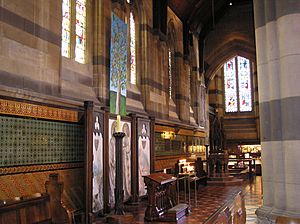
St Paul's Cathedral has been the location for many important events in Australia's history. It is often chosen for state funerals. Many prime ministers, premiers, governors, and other important people have had their funerals here.
Papal Visit
On November 28, 1986, Pope John Paul II visited St Paul's Cathedral when he arrived in Melbourne. This visit showed the good relationship between the Anglican and Roman Catholic churches in Melbourne.
The cathedral choir sang a special song as the Pope entered. The Pope then prayed for Christian unity and lit a large candle. A special chapel inside the cathedral remembers this historic event. It was only the third time in 400 years that a Pope had officially visited an Anglican cathedral.
Christmas Carol Service
On November 28, 2007, a carol service called Carols from St Paul's Cathedral Melbourne was recorded. It featured the cathedral choir. The recording was broadcast across Australia on Christmas Eve.
Services Held
Sunday Services
- 8:00 am: Holy Communion (using an older prayer book)
- 10:00 am: Choral Eucharist (with singing, using a modern prayer book)
- 4:00 pm: Choral Evensong (with singing)
Weekday Services
- Monday:
- 12:15 pm: Eucharist
- 5:10 pm: Evening Prayer in Simple English
- Tuesday to Friday:
- 12:15 pm: Eucharist
- 5:10 pm: Choral Evensong (Evening Prayer during school holidays)
Public Holidays
- 12:15 pm: Eucharist
See also
 In Spanish: Catedral de San Pablo de Melbourne para niños
In Spanish: Catedral de San Pablo de Melbourne para niños


